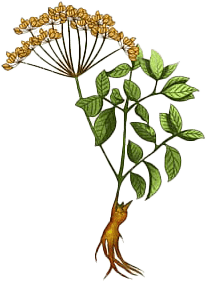
By Cat Gina Cole
Today as I open my journal from 2014, I find angelica. What I find interesting about this herb is it has so many lookalikes. Pretty much the entire family of umbelliferae are lookalikes for angelica. The family includes about 460 genera and 4,250 species.
 Also known as Masterwort, Dong Quai, Archangel, and Alexanders. A biennial with a dark turnip-like rhizome and stout roots which bear in the first year, Angelica is robust and long-haired. It is covered with a whitish film and grows to 6 feet tall. Its leaves are large and pinnately divided into lance-shaped and minutely toothed leaflets. Angelica has a basal rosette of leaves and in the second year a tall multi-branched, furrowed, and hollow, leafy, green stem. The petiole is long and clasping at the base. The small flowers are gathered in umbelles that are arranged in larger umbels from June to September. The umbels are flattened on the top and the fruit is double achene with oblong side ribs longer than the midribs and has thin wings at the edge and the fruit/seed is aromatic when crushed.
Also known as Masterwort, Dong Quai, Archangel, and Alexanders. A biennial with a dark turnip-like rhizome and stout roots which bear in the first year, Angelica is robust and long-haired. It is covered with a whitish film and grows to 6 feet tall. Its leaves are large and pinnately divided into lance-shaped and minutely toothed leaflets. Angelica has a basal rosette of leaves and in the second year a tall multi-branched, furrowed, and hollow, leafy, green stem. The petiole is long and clasping at the base. The small flowers are gathered in umbelles that are arranged in larger umbels from June to September. The umbels are flattened on the top and the fruit is double achene with oblong side ribs longer than the midribs and has thin wings at the edge and the fruit/seed is aromatic when crushed.
HARVEST: Whole plants when flowering, collect seeds in late summer when they turn from green to yellow and are covered with a straw-like substance.
WHERE FOUND: Moist or dry shady areas, woods, Southern California to North Coast Ranges, to Southern Oregon.
CONTAINS: Valeric acid, angelic acid, Angelicum, safrole, scopoletin, Linoleic, acid, b-12, zinc, thiamine, sucrose, riboflavin, potassium, magnesium, iron, fructose, glucose. essential oils with phellandrene and limonene, coumarin glycosides, organic acids, bitter compounds, tannins, and sugars.
ACTIONS: Carminative, diaphoretic, emmenagogue, anti-bacterial, glycogen, diuretic expectorant, aperitif, stomachic, antiseptic, antibacterial
USES: Cough, cold, fevers, sedative, tonic, stomach complaints, broken bones, swellings, acne, itching, rheumatism, diabetes, sore throat, cold sores.
Indigenous Americans burned the twigs, then beat aching joints with them. Juice from the heated leaves was rubbed on sores. The root when chewed or held in the mouth was done to treat a sore throat, hoarseness, bad breath, or to relieve a stomachache. The root was boiled to make a wash for bathing sores.
Externally, a root poultice was used to treat headaches. Smoke from the burning plant was sometimes inhaled as a headache remedy too. The Cherokee used the root in tonics for fevers, colds, as a gargle for sore throat, mouth pain, and cold sores. The young shoots of the stalk are edible in salads or in soups and stews and have a sweet taste similar to celery.
Angelica is a common garden plant and is cultivated commercially in several countries for medicinal and perfumery uses. Its leaf stalks can be candied and are preserved in sugar and used in confectionery or as flavoring in liqueurs. The roots and fruits of angelica are used medicinally. The constituents it contains gives angelica carminative, stomachic, and antispasmodic actions. It is used internally in particular for loss of appetite, flatulence, and bronchial catarrh. Externally, it is used in bath preparations for exhaustion and rheumatic pain and in gargles.
WARNING: Contains furocoumarins, which can cause photosensitivity and cause health issues, especially for those taking coumarin. There are enormous amounts of vitamins like vitamin B12, thiamin, folic acid, biotin, and minerals such as magnesium, thiamin, potassium, iron, riboflavin, etc. So be careful about not overdoing the vitamins as not all vitamins leave the body readily. Angelica roots also have glucose, sucrose, and fructose that enhances body’s energy. Avoid misidentification with toxic members of parsley family like hemlock.
MAGIC: Planet- sun, Gender – feminine Element – fire
Angelica is a plant whose name has been surrounded by myth and legend for centuries. Its Latin name is Angelica Archangelica and it is said to bloom every year on May 8th, the feast day of Archangel Michael. It is used for protection and exorcism. Grow it in the garden to protect the home. Make necklaces of the leaves or carry the root for protection. Dried leaves are burned for exorcism and burning them in the home is said to give a joyful outlook.
Sprinkle all corners of the house with dried leaves for protection and to ward off evil. Added to the bath it removes curses, hexes, and any spells against you. The root was carried in the pocket among some Native Americans. It is used in healing incenses and mixtures. Smoking the leaves is said to bring visions.
 Cat Gina Cole is a Hereditary Witch and author of Psychic Skills for Magic and Witchcraft (Llewellyn, 2022). She is the founder of The Coven of the Rising Phoenix and Staff Coordinator for “Green Egg Magazine.” You can reach her at www.catginacole.com.
Cat Gina Cole is a Hereditary Witch and author of Psychic Skills for Magic and Witchcraft (Llewellyn, 2022). She is the founder of The Coven of the Rising Phoenix and Staff Coordinator for “Green Egg Magazine.” You can reach her at www.catginacole.com.